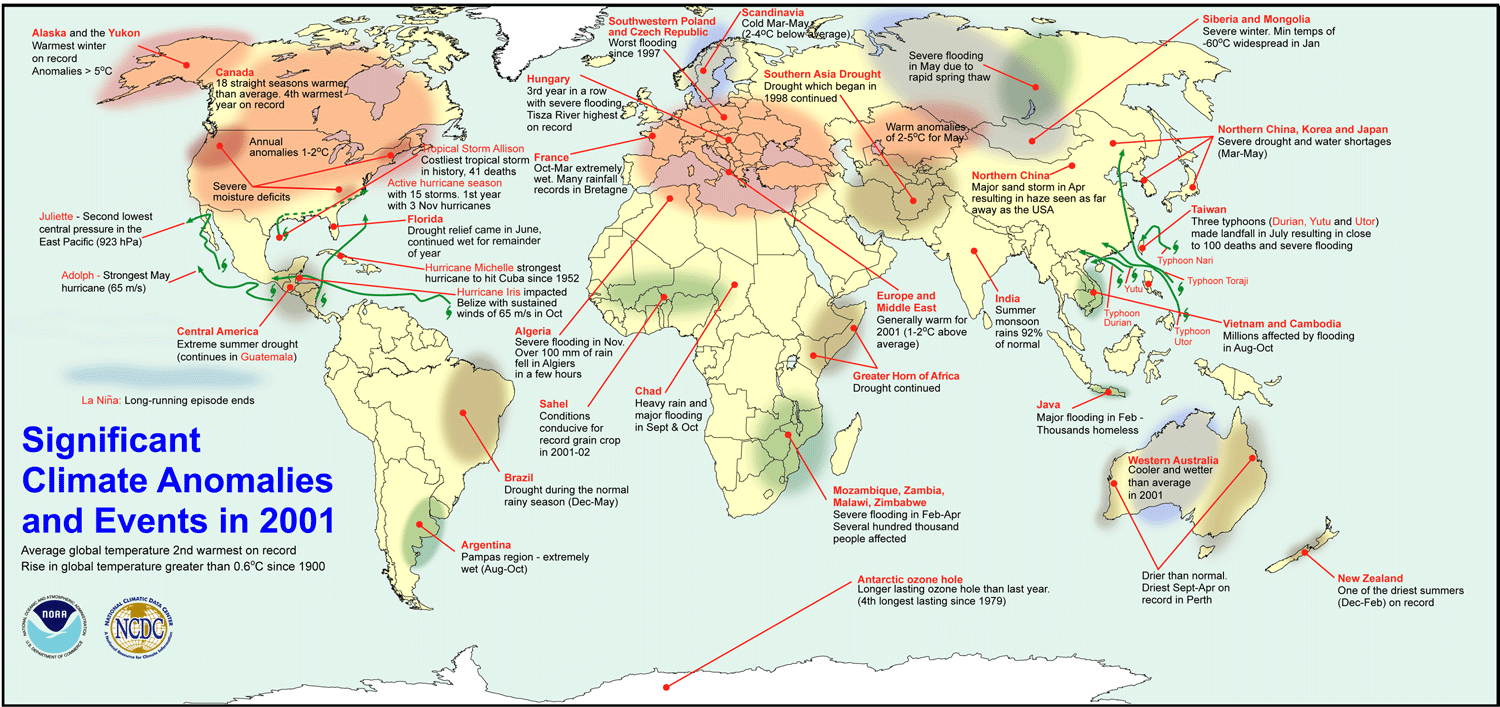
PLEASE NOTE: The ranks and temperature anomalies in this report represent the values known at the time the report was issued. The actual ranks will change as subsequent years are added to the dataset. The anomalies themselves may change slightly as missing or erroneous data is resolved. Also, in 2009, NCDC switched to ERSST version 3b (from version 2) as a component of its global surface temperature dataset. Because the versions have slightly different methodologies, the calculated temperature anomalies will differ slightly. For more information about this switch please see the Global Surface Temperature Anomalies FAQ .
Global Temperatures
| Global temperatures in 2001 were 0.51°C (0.92°F)* above
the long-term (1880-2000) average**, which places 2001 as the
second warmest year on record. The only warmer year was 1998 in
which a strong El Niño contributed to higher global
temperatures. Land temperatures were 0.75°C (1.35°F)* above
average and ocean temperatures 0.40°C (0.72°F)* above the
1880-2000 mean. This ranks them as 2nd and 3rd warmest on record
respectively. A weak La Niña persisted into early 2001 in the tropical Pacific but neutral ENSO conditions developed and were maintained throughout the latter half of the year. Near-normal or weak positive anomalies (El Niño) conditions are expected to persist through the early part of 2002. The Northern Hemisphere temperature continues to average near record levels in 2001 at 0.60°C (1.08°F) above the long-term average. The Southern Hemisphere also reflects the globally warmer conditions, with a positive anomaly of 0.43°C (0.77°F). Annual anomalies in excess of 1.0°C (1.8°F) were widespread across North America and much of Europe and the Middle East. *Updated anomalies using most recent station data and NCEP
OI Version 2 anomalies. |
Regional Temperatures
 larger image |
Despite pre-existing La Niña conditions, global temperatures were above average during 2001. The adjacent figure depicts the warmer than average temperatures that were widespread across much of the United States as well as most of Europe. Temperatures in these regions were 1-3°C (1.8-5.4°F) above the 1961-1990 average. The only widespread area of negative anomalies was across Australia, where temperatures were between 1 and 3°C (1.8-5.4°F) cooler than average. |
| Notable temperature extremes during 2001 included one of the harshest winters in decades across Siberia and Mongolia. Extreme minimum temperatures as low as -50°C (-70°F) were observed in the Kemerovo region of Russia during mid-January. High heat affected drought-plagued areas of the Middle East, with maximum temperatures reaching as high as 50°C (122°F) in parts of Pakistan during early May, resulting in dozens of deaths. |
Global Precipitation
 larger image |
Global precipitation was below the 1961-1990 average in 2001. A drought which has persisted for nearly 3 years continued in 2001 across Afghanistan, Pakistan and neighboring countries. In Iran alone, estimated agricultural losses approached $2.6 billion (USD). Much of Central America experienced drought during the middle part of the year, which is traditionally the rainy season. Late season tropical activity eased drought in these areas, although drought in Honduras and neighboring regions continued through the latter part of 2001. In Africa, drought in Kenya persisted during 2001, despite one of the wettest Januaries in 40 years. In Australia, drought affected much of Western Australia and parts of Queensland. |
| Several typhoons brought excessive rains to parts of southeast Asia, including the southeast coast of China, Taiwan, the Philippines and Vietnam. Monsoon rains in southeast Asia promoted extensive flooding along the Mekong Delta with at least several hundred deaths between August and October. Across Siberia, spring rains and a rapid thaw brought flooding across a vast area from the Ural Mountains to the Russian Far East, with some of the worst flooding in the Sakha region along the Lena River. A third consecutive year of spring flooding along the Tisza River in Hungary displaced tens of thousands of people from their homes, with the Tisza rising to its highest level in 100 years by early March. |
References
IPCC, 2001: Climate Change 2001: The Scientific Basis, Contribution of Working Group I to the Third Assessment Report of the Intergovernmental Panel of Climate Change. J.T. Houghton, Y. Ding, D.J. Griggs, M. Noguer, P.J. vander Linden, X.Dai, K. Maskell, and C.A. Johnson (Eds.), Cambridge University Press, 881 pp.

NOAA's National Climatic Data Center is the world's largest active archive of weather data. The preliminary temperature and precipitation rankings are available from the center by calling: 828-271-4800.
NOAA works closely with the academic and science communities on climate-related research projects to increase the understanding of El Niño and improve forecasting techniques. NOAA's Climate Prediction Center monitors, analyzes and predicts climate events ranging from weeks to seasons for the nation. NOAA also operates the network of data buoys and satellites that provide vital information about the ocean waters, and initiates research projects to improve future climate forecasts.
 NOAA's National Centers for Environmental Information
NOAA's National Centers for Environmental Information